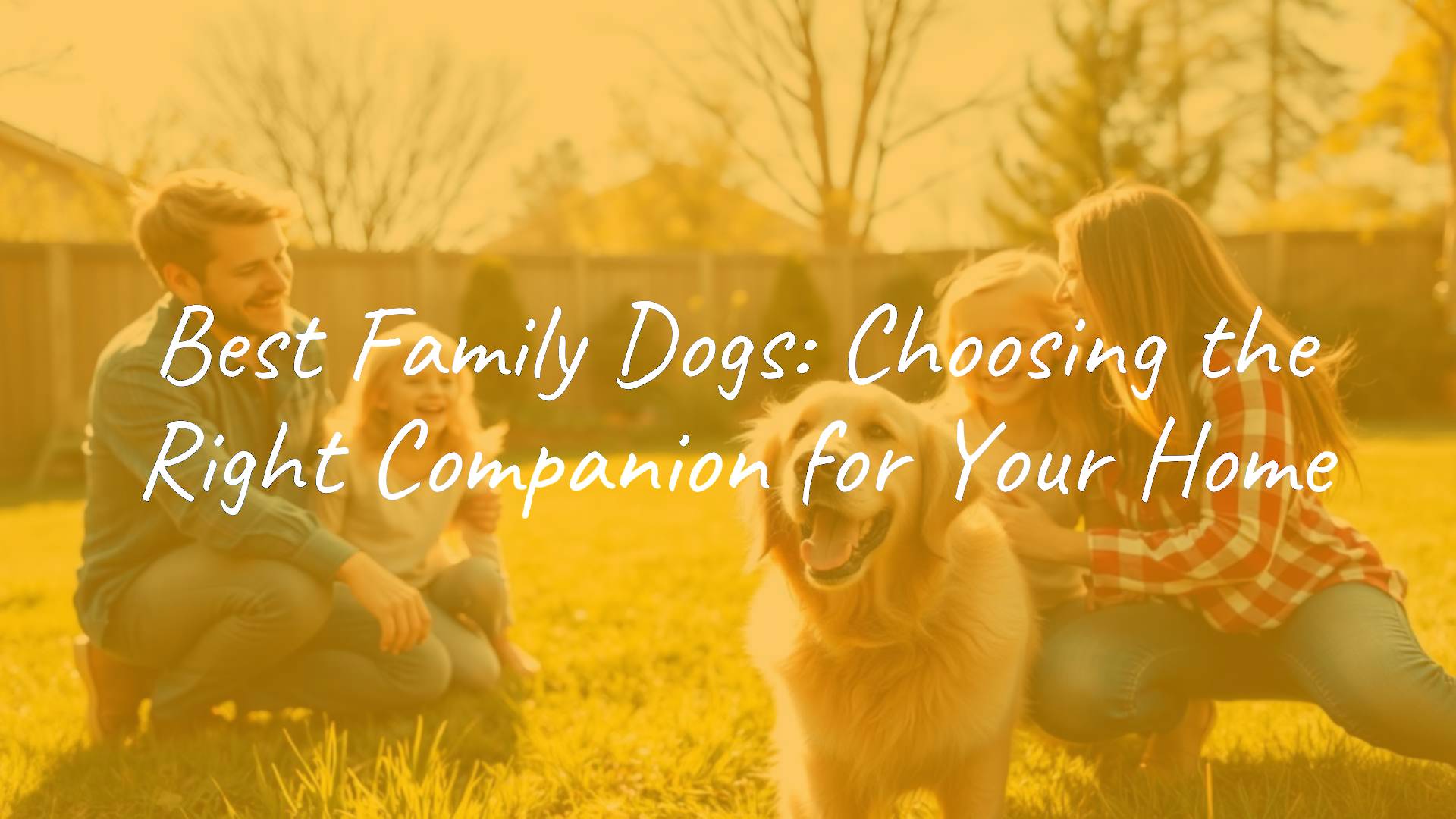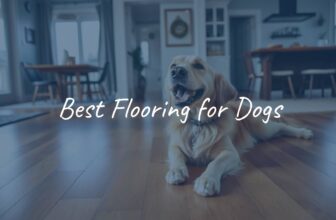
Picking the best family dog depends on your home, routine, and what your family likes to do. The right dog for one family might be a lively buddy for games, while another family might want a calm snuggler. This guide walks you through how to choose a dog that brings joy, company, and some fun, happy noise to your home for years.
We’ll cover what makes a dog family-friendly and look at breeds and their traits. Get ready to find which wagging tail could be the right match for your household.
What Makes a Dog the Best for Families?
When people think of a great family dog, a few traits come to mind. You want a dog that fits into daily life, brings smiles, and feels like part of the family. The goal is a mix of the right personality and the ability to adapt.
A good family dog can handle active play with kids and also relax on the couch. They should be sturdy enough for clumsy hugs from toddlers, yet gentle when it’s time to be calm. A family dog adds love, comfort, and many happy memories.
Common Characteristics of Great Family Dogs
- Friendly and social: enjoys meeting people and other pets
- Affectionate: bonds with all family members
- Patient: stays calm with kids and busy homes
- Trainable: learns rules and routines quickly
- Steady temperament: not shy or aggressive
Benefits of Having a Family Dog
- Companionship: a steady friend who brings comfort
- More activity: walks, playtime, and outdoor fun
- Life lessons for kids: responsibility, empathy, and kindness
- Stress relief: a happy greeting after a long day
- Shared moments: memories that bring your family closer

Are Mixed Breed Dogs Good for Families?
Yes. Mixed-breed dogs, or “mutts,” can be wonderful family pets. Shelters often share “report cards” that outline a dog’s known traits, which helps you pick a dog that fits your needs.
Mixed-breed dogs often have wider genetic variety, which can sometimes lower the risk of certain inherited issues seen in some purebreds. Shelters and rescues are full of amazing mixed-breed dogs ready for a home. Be sure to include them in your search.
How to Pick the Right Dog Breed for Your Family
Choosing a dog is a big step-like adding a new family member. Think carefully about what you can offer a dog and what you hope for in return. Falling for a cute face is easy, but a good match with your lifestyle matters most.
The right dog will be comfortable in your home, enjoy your activities, and fit into your daily routine. By weighing key points, you can help your family and your dog live happily together.
Key Factors to Think About Before Choosing
Before you start looking at breeds, pause and think about your family. Dr. Antje Joslin, a veterinarian at Dogtopia, suggests looking at your lifestyle, home size, activity level, and the number and ages of people in your household. Do you have young kids who need a gentle buddy, or older kids who want an active partner?
Consider your time for walks, grooming, and training. Do you want a dog that needs lots of mental activity, or one that’s more easygoing? Honest answers will help narrow the huge range of breeds to those that match your family.
Matching Dog Size to Your Living Space
Size matters. An extra-large Newfoundland might struggle in a small apartment, while a Cavalier King Charles Spaniel or Boston Terrier can do well in tight spaces. Small breeds often adapt well to city living.
If you have a big yard, a larger dog like a Golden Retriever or Bernese Mountain Dog may fit better, especially with room to run. Matching a dog’s needs with your space helps keep both you and your pet comfortable and lowers stress.

Activity Level: Does Your Dog Need Lots of Exercise?
Match a dog’s energy level to your family’s habits. If you love hikes, runs, and frequent outings, an Irish Setter, Labrador Retriever, or Golden Retriever may suit you. These dogs need plenty of exercise and mental games.
If your family prefers shorter walks and indoor play, a lower-energy breed like a Pug or Cavalier King Charles Spaniel may be better. Dogs who don’t get enough activity can get restless or destructive, so honest planning here matters a lot.
Shedding and Coat Type: Cleaning and Care
Coat type and shedding affect daily life. Breeds like Bernese Mountain Dogs and Golden Retrievers shed heavily and need frequent brushing and extra cleaning at home. If you have allergies or prefer a cleaner house, think about this carefully.
Poodles and Bichon Frises shed less and may be easier on some allergy sufferers (though no dog is 100% hypoallergenic). These breeds often need professional grooming every four to six weeks. Make sure you can keep up with grooming before you choose.
Trainability and Intelligence in Family Dogs
Smart, trainable dogs fit well in busy homes. Labrador Retrievers, Golden Retrievers, and Poodles are known for learning quickly and being keen to please, which helps with manners and skills. This matters a lot for a peaceful home.
Some breeds can be strong-willed, but steady training and early social time can help any dog thrive. Even smart dogs need brain games, so plan for training sessions, puzzle toys, and other activities.
Barking Level and Noise Sensitivities
Barking style matters, especially with close neighbors. Beagles love to voice their feelings, and Keeshonds may bark to greet or alert. That can be charming or challenging, depending on your setting.
If you want a quieter home, look for breeds that tend to be less vocal. If you want an alert dog, a more talkative breed can fit-just be ready to manage their “opinions.”
Compatibility with Children and Other Pets
With kids at home, pick a dog known for patience and a gentle nature. Golden Retrievers and Labradors are famous for being kind with children. Newfoundlands are often called “nanny dogs” because of their calm ways with babies and toddlers.
If you have other pets, choose a dog that plays well with others. Bichon Frises and Flat-Coated Retrievers often get along with other dogs and even cats. Research natural instincts and use slow, careful introductions and early social time to help all pets live well together.
Most Popular Dog Breeds for Families
Some breeds often show up on “best family dog” lists thanks to their friendly nature and ability to fit into family life. They tend to be patient, loving, and easy to train. Here are a few favorites.

Labrador Retriever
Labs are among the most popular breeds in the U.S. These 55-80 lb dogs are friendly, outgoing, and gentle. They love people, mix well with most dogs, and make great companions for kids of all ages.
Labs are smart and keen to please, but they have lots of energy. They need daily exercise like fetch and swimming and do best with active families and space to move. Daily walks help keep them happy and out of trouble. Lifespan: about 12-14 years.
Golden Retriever
Goldens (around 60-80 lbs) are often seen as the classic family dog. They’re friendly, patient, and affectionate with kids and other pets. They learn quickly, love people, and stay playful into adulthood. Lifespan: 10-12 years.
Goldens need regular exercise and do best in active homes with a yard. Their thick golden coats shed and need brushing. They can face hip issues and some cancers, so regular vet care matters a lot.
Beagle
Beagles (18-30 lbs) are cheerful, loyal, and curious. They are great with kids and other dogs and love to play. They have a strong sense of smell and enjoy following scents. Lifespan: 10-15 years.
Beagles need steady training and enough exercise to stay calm and content. They enjoy time with their people and are not a good pick for families away from home for long hours.
Poodle
Poodles come in Standard (45-60 lbs), Miniature, and Toy sizes. They are bright, trainable, and affectionate. Their low-shedding coats can help some allergy sufferers, but they still need regular grooming. Lifespan: 10-18 years.
Poodles are lively and fun, often with a goofy sense of humor. They are easy to train but may face hip and eye issues, so keep up with vet checks and grooming every four to six weeks.
Cavalier King Charles Spaniel
Cavaliers (10-18 lbs) are loving, gentle, and friendly-great for apartments and smaller homes. They bond closely with families and do well with young children. Lifespan: 12-15 years.
They adapt to both relaxed and active homes, enjoying short walks and lots of cuddles. They’re smart and keen to please, which helps with training. Watch for possible heart and neurological issues.
Bernese Mountain Dog
Berners (70-115 lbs) are big, calm, and sweet. They are known for being gentle with kids despite their size and make devoted family dogs. Lifespan: 8-10 years.
They like being part of family life and staying close. They shed a lot and need regular brushing and space to move. Expect extra vacuuming-and extra cuddle time.
Newfoundland
Newfies (100-150 lbs) are gentle giants with a kind, patient nature. They’re often called “nanny dogs” because they are so good with children, even babies. Lifespan: 9-10 years.
They are calm and steady but need room due to their size. Early social time helps them learn good manners, as they may forget how big they are. With training, they become loyal, loving family members.
Boxer
Boxers are playful, energetic, and loyal. Medium to large in size, they love their families and often watch over them. Lifespan: 10-12 years.
They can be strong-willed, so steady training and early social time matter. They need good exercise. Health-wise, Boxers can face heart issues, hip problems, and some cancers, so regular vet visits are important.
Irish Setter
Irish Setters are loving, goofy, and curious. These large dogs are friendly with kids and other pets and fit well in active homes. Lifespan: 12-15 years.
They need lots of exercise and space to run, plus time with active owners who enjoy outdoor fun. Their red coats are striking and need regular care.
Bichon Frise
Bichons (12-18 lbs) are cheerful, affectionate, and playful. They do well in apartments and smaller homes. Their coats shed less, which may help some allergy sufferers, but they need trims and brushing, often every four to six weeks. Lifespan: 14-15 years.
They get along with kids and other pets and enjoy daily play but are not high-energy. They can face skin and allergy issues, so watch their health and grooming.
Collie
Collies (50-75 lbs) are loyal, smart, and gentle, often used as service or therapy dogs. They are playful and tend to be very friendly and protective of family. Lifespan: 12-14 years.
They may show herding behaviors but are usually easy to train. They do well with active families. Homes with older kids are best, as Collies can be uneasy around very small children who don’t know boundaries yet.
Boston Terrier
Boston Terriers (25 lbs or less) are charming, people-focused, and great with kids. Their short “tuxedo” coats are easy to care for, and they handle apartment living well. Lifespan: 11-13 years.
They enjoy short walks and indoor play. Their small size and flexible nature make them a good pick for families with limited space.
Havanese
Havanese (7-13 lbs) are playful, loving, and outgoing. They are great with kids and fit well in apartments and smaller homes. Lifespan: 14-16 years.
They are smart and happy to learn tricks and new cues. They thrive on human company and make loyal family companions.
Mixed Breed and Rescue Dogs
Mixed-breed and rescue dogs deserve attention too. They come with many shapes, sizes, and personalities. Shelter teams are skilled at evaluating dogs and can guide you to a good match.
Mixed-breed dogs may face fewer breed-specific issues due to genetic variety. Adopting a rescue gives a loving dog a new home and brings a caring friend into your life. Stay patient and keep an open mind while exploring the wide range of mixed breeds and rescues.
Comparing Top Family Dog Breeds
With many great choices, it can feel hard to pick. Comparing breeds across a few key points can help you match their traits with your family’s needs.
| Breed | Size | Energy | Shedding | Lifespan |
|---|---|---|---|---|
| Labrador Retriever | Large | High | Moderate | 12-14 yrs |
| Golden Retriever | Medium/Large | High | Moderate/High | 10-12 yrs |
| Poodle (Std.) | Medium/Large | Medium/High | Low | 10-18 yrs |
| Beagle | Small/Medium | High | Moderate | 10-15 yrs |
| Cavalier King Charles | Small | Low/Medium | Moderate | 12-15 yrs |
| Bernese Mountain Dog | Large | Medium | High | 8-10 yrs |
Size and Energy Needs
Size and energy often go hand in hand. Newfoundlands and Bernese Mountain Dogs are large and gentle, great with kids but in need of space. Their size alone calls for room to move.
Golden Retrievers and Labrador Retrievers are sturdy and active, needing daily exercise. Smaller dogs like Cavaliers and Boston Terriers fit well in apartments and need less space and activity time.
Grooming Requirements
Grooming needs vary a lot. Golden Retrievers and Collies have longer coats that need frequent brushing. Bernese Mountain Dogs shed heavily and need steady coat care.
Poodles and Bichon Frises shed less but need trims every four to six weeks. Boston Terriers and Labs have short coats that are easier to manage. Be honest about the time and budget you can put into grooming.
Temperament Differences
Temperament is the most important point for many families. Labs and Goldens are famous for being friendly, patient, and outgoing. Newfoundlands are gentle with kids. Beagles are playful and love family time.
Nuances matter. Collies are adaptable and protective but can be uneasy with very young kids. Boxers are loving yet strong-willed and need steady training. Knowing these differences helps you pick a dog that fits your family’s style.
Best Family Dogs for Allergy Sufferers
No dog is 100% hypoallergenic, but some shed less dander. Poodles (all sizes) are often suggested because their curly coats shed less.
Bichon Frises are another good pick for some allergy sufferers. Other breeds to look at include Portuguese Water Dogs and Soft Coated Wheaten Terriers. Spend time with a dog before you adopt to see how your allergies react.
What to Know Before Bringing Home a Family Dog
Getting ready for a new dog is exciting, but the days before they arrive, and the first weeks at home, matter a lot for a smooth start. Good prep and clear plans lay the groundwork for a happy, well-adjusted pet.
Bringing a dog home is a long-term commitment. It takes patience, steady routines, and love. With some planning, you help your family and your new friend get off to a good start.
Preparing Your Home and Family
- Dog-proof your space: store chemicals, secure trash, move breakables, and keep toxic plants out of reach.
- Set up a safe spot: a bed, crate, or quiet corner for rest and downtime.
- Gather supplies: food, bowls, leash, collar or harness, ID tags, toys, poop bags, and grooming tools.
- Plan routines: feeding times, potty breaks, walks, play, and training.
- Set family rules: who feeds, who walks, and how to handle training. Teach kids gentle handling and respect for the dog’s space.
Training Tips for a Well-Behaved Family Dog
- Start right away: use the same commands and reward good behavior.
- Use positive methods: treats, praise, and play work better than punishment.
- Begin with basics: sit, stay, come, down; also house training and leash skills.
- Social time: expose your dog to sights, sounds, people, and friendly pets early on.
- Be steady with strong-willed breeds (like Boxers): short, frequent sessions help.
- Consider puppy classes or a trainer if you want extra help.
Caring for Your Dog’s Health and Happiness
Preventive vet care is needed for a long, healthy life. Book a first visit soon after adoption to set up care, vaccines, deworming, and parasite prevention. Regular checkups help catch problems early.
Feed a balanced diet, provide daily exercise that fits the breed, and add mental games and training. Offer a comfy sleeping area, fresh water, and safe play. Most of all, give time, attention, and steady care to build a strong bond.
How to Introduce a Dog to Children and Other Pets
Plan and supervise early meetings. Teach kids how to approach gently and respect the dog’s space. Always watch interactions with young children and don’t leave them alone with a new dog.

For other pets, start on neutral ground. Keep first meetings short and positive with both animals on leashes. Increase time together slowly and give each pet a safe place to retreat. Breeds like Golden Retrievers and Flat-Coated Retrievers often do well with other pets, but smart, careful introductions are always important.
Frequently Asked Questions About Family Dogs
Which Dogs Are the Safest for Young Children?
No dog is “safe” without training and supervision, but some breeds are known for patience and a soft touch with kids. Labrador Retrievers and Golden Retrievers are common choices because they are friendly, tolerant, and happy to please. Newfoundlands are calm and often do well even with babies and toddlers.
Cavalier King Charles Spaniels are gentle and loving, too. Remember, every dog is an individual. Meet the specific dog, start social time early, keep up with training, and always supervise time with young children.
How Do I Know If a Dog Is Right for My Family?
It takes a full review of both the dog and your lifestyle. Look at temperament: outgoing or shy? Energy level: high or low? Active families often enjoy high-energy dogs; more laid-back homes may prefer calmer companions.
Think about size and space, plus grooming needs. Look at how easy the dog is to train and how much it tends to bark. Watch how the dog interacts with all family members, including kids and other pets. The team at Stoney Creek Veterinary Hospital suggests thinking about your limits and what you can offer a new dog. Visit shelters, ask questions, and take your time.
Are There Family Dogs That Don’t Shed Much?
Yes. Poodles (Standard, Miniature, and Toy) shed less and are often suggested for people who want fewer loose hairs around the house. Their coats do need regular professional grooming.
Bichon Frises and Havanese are also popular low-shedding options with friendly temperaments. While no dog is fully shed-free or 100% hypoallergenic, these breeds may suit people with mild allergies. Spend time with a dog first to see how you react before you commit.






